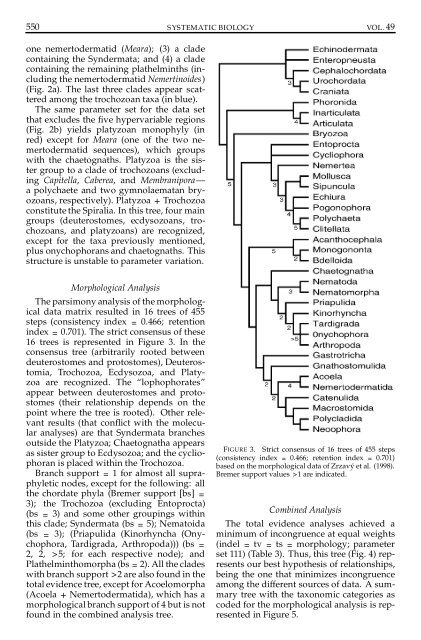Triploblastic Relationships with Emphasis on the Acoelomates and ...
Triploblastic Relationships with Emphasis on the Acoelomates and ...
Triploblastic Relationships with Emphasis on the Acoelomates and ...
You also want an ePaper? Increase the reach of your titles
YUMPU automatically turns print PDFs into web optimized ePapers that Google loves.
550 SYSTEMATIC BIOLOGY VOL. 49<br />
<strong>on</strong>e nemertodermatid (Meara); (3) a clade<br />
c<strong>on</strong>taining <strong>the</strong> Syndermata; <strong>and</strong> (4) a clade<br />
c<strong>on</strong>taining <strong>the</strong> remaining pla<strong>the</strong>lminths (including<br />
<strong>the</strong> nemertodermatid Nemertinoides)<br />
(Fig. 2a). The last three clades appear scattered<br />
am<strong>on</strong>g <strong>the</strong> trochozoan taxa (in blue).<br />
The same parameter set for <strong>the</strong> data set<br />
that excludes <strong>the</strong> �ve hypervariable regi<strong>on</strong>s<br />
(Fig. 2b) yields platyzoan m<strong>on</strong>ophyly (in<br />
red) except for Meara (<strong>on</strong>e of <strong>the</strong> two nemertodermatid<br />
sequences), which groups<br />
<str<strong>on</strong>g>with</str<strong>on</strong>g> <strong>the</strong> chaetognaths. Platyzoa is <strong>the</strong> sister<br />
group to a clade of trochozoans (excluding<br />
Capitella, Caberea, <strong>and</strong> Membranipora—<br />
a polychaete <strong>and</strong> two gymnolaematan bryozoans,<br />
respectively). Platyzoa + Trochozoa<br />
c<strong>on</strong>stitute <strong>the</strong> Spiralia. In this tree, four main<br />
groups (deuterostomes, ecdysozoans, trochozoans,<br />
<strong>and</strong> platyzoans) are recognized,<br />
except for <strong>the</strong> taxa previously menti<strong>on</strong>ed,<br />
plus <strong>on</strong>ychophorans <strong>and</strong> chaetognaths. This<br />
structure is unstable to parameter variati<strong>on</strong>.<br />
Morphological Analysis<br />
The parsim<strong>on</strong>y analysis of <strong>the</strong> morphological<br />
data matrix resulted in 16 trees of 455<br />
steps (c<strong>on</strong>sistency index = 0.466; retenti<strong>on</strong><br />
index = 0.701). The strict c<strong>on</strong>sensus of <strong>the</strong>se<br />
16 trees is represented in Figure 3. In <strong>the</strong><br />
c<strong>on</strong>sensus tree (arbitrarily rooted between<br />
deuterostomes <strong>and</strong> protostomes), Deuterostomia,<br />
Trochozoa, Ecdysozoa, <strong>and</strong> Platyzoa<br />
are recognized. The “lophophorates”<br />
appear between deuterostomes <strong>and</strong> protostomes<br />
(<strong>the</strong>ir relati<strong>on</strong>ship depends <strong>on</strong> <strong>the</strong><br />
point where <strong>the</strong> tree is rooted). O<strong>the</strong>r relevant<br />
results (that c<strong>on</strong>�ict <str<strong>on</strong>g>with</str<strong>on</strong>g> <strong>the</strong> molecular<br />
analyses) are that Syndermata branches<br />
outside <strong>the</strong> Platyzoa; Chaetognatha appears<br />
as sister group to Ecdysozoa; <strong>and</strong> <strong>the</strong> cycliophoran<br />
is placed <str<strong>on</strong>g>with</str<strong>on</strong>g>in <strong>the</strong> Trochozoa.<br />
Branch support = 1 for almost all supraphyletic<br />
nodes, except for <strong>the</strong> following: all<br />
<strong>the</strong> chordate phyla (Bremer support [bs] =<br />
3); <strong>the</strong> Trochozoa (excluding Entoprocta)<br />
(bs = 3) <strong>and</strong> some o<strong>the</strong>r groupings <str<strong>on</strong>g>with</str<strong>on</strong>g>in<br />
this clade; Syndermata (bs = 5); Nematoida<br />
(bs = 3); (Priapulida (Kinorhyncha (Onychophora,<br />
Tardigrada, Arthropoda))) (bs =<br />
2, 2, >5; for each respective node); <strong>and</strong><br />
Pla<strong>the</strong>lminthomorpha (bs = 2). All <strong>the</strong> clades<br />
<str<strong>on</strong>g>with</str<strong>on</strong>g> branch support >2 are also found in <strong>the</strong><br />
total evidence tree, except for Acoelomorpha<br />
(Acoela + Nemertodermatida), which has a<br />
morphological branch support of 4 but is not<br />
found in <strong>the</strong> combined analysis tree.<br />
FIGURE 3. Strict c<strong>on</strong>sensus of 16 trees of 455 steps<br />
(c<strong>on</strong>sistency index = 0.466; retenti<strong>on</strong> index = 0.701)<br />
based <strong>on</strong> <strong>the</strong> morphological data of Zrzav ´y et al. (1998).<br />
Bremer support values >1 are indicated.<br />
Combined Analysis<br />
The total evidence analyses achieved a<br />
minimum of inc<strong>on</strong>gruence at equal weights<br />
(indel = tv = ts = morphology; parameter<br />
set 111) (Table 3). Thus, this tree (Fig. 4) represents<br />
our best hypo<strong>the</strong>sis of relati<strong>on</strong>ships,<br />
being <strong>the</strong> <strong>on</strong>e that minimizes inc<strong>on</strong>gruence<br />
am<strong>on</strong>g <strong>the</strong> different sources of data. A summary<br />
tree <str<strong>on</strong>g>with</str<strong>on</strong>g> <strong>the</strong> tax<strong>on</strong>omic categories as<br />
coded for <strong>the</strong> morphological analysis is represented<br />
in Figure 5.

















